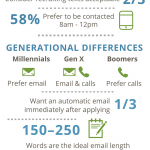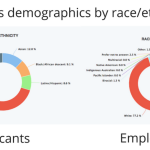The Top 3 Factors That Will Make Or Break Your Recruitment In 2017
We’re days away from 2017, but many companies are still hiring like it’s 2010. The entire hiring process—from the way job seekers find listings to the way recruiters reach out to prospects—has evolved quite a bit in the past few years.
Now it’s time for every employer to catch up to the times, lest lose the top talent to competitors that beat them to it. These are three factors that, more and more, will make or break a company’s recruiting in the year ahead.
1. Mobile First
Mobile internet traffic surpassed web traffic three whole years ago already, in 2014. That shift has now worked its way into the job search, with 77% of job seekers using mobile devices to look for new opportunities.
For employers, mobile-first recruiting is now nonnegotiable. Many are responding by creating mobile-friendly websites and using responsive design to improve the navigation experience on all devices. That’s a great start, but it’s only part of the solution. Mobile-driven recruitment needs to cover two other bases as well:
Content: Every bit of content you develop in order to draw in talent needs to be written with the expectation it’ll be viewed on mobile. This includes your career site copy, job descriptions, blog posts, and any other recruiting collateral. You may have a responsive site, but if you’re making job seekers scroll and scroll in order to see your copy, you’re likely to lose them.
Technology: Your career site isn’t the only thing that needs to be optimized for mobile. Many organizations use an “applicant tracking system” (ATS) as their core recruiting software. Some make the mistake of building a dazzling mobile-optimized career site, only to then direct applicants to an antiquated ATS that isn’t not mobile-friendly. If you don’t provide an end-to-end mobile application experience, you’re leaving weak links in your application chain.
2. Candidate Experience
Have you ever applied to one of your company’s job? How long did it take? And how painful was it? Go ahead and try it! This is the simplest audit you can possibly do, and it’s one of the first steps in gauging your “candidate experience,” or CX, which is now a factor employers can’t afford to ignore.
Your goal should simply be to make it as easy as possible for candidates to apply. The less friction (i.e., time) in the application process, the better. If niche talent that rarely “looks” for a job is the focus of your recruiting, yet it takes 20 minutes to complete your application, you’re in trouble.
Indeed.com recently audited the application processes of every Fortune 500 company. What did industry-leading companies like Apple, Netflix, and Salesforce have in common? Their job applications each took less than 15 minutes. The median time was 13 minutes. If you find yourself going beyond that, you may be losing applicants.
Another common CX mistake is the dreaded “black hole,” where job seekers never actually learn whether and at what point they’re taken out of the running. It’s an all-too-common result of recruiting workflows built for speed and scale that lack basic empathy, but there are real costs to this—and they’re rising. Social media and sites like Glassdoor make it easy for frustrated candidates to amplify their negative interview experiences, which can swiftly damage an employer’s reputation and turn prospects away.
A poor hiring experience can cost your organization more than just talent, though—it can mean lost revenue. In many cases, job candidates are also customers. Virgin Media recently linked negative candidate experience to lost customers (and revenue), and found that its poor hiring practices cost the company approximately £5.3 million per year.
3. Employer Brand
Today’s job seekers have a broad range of tools to research companies, cultures, and individuals. That means every company has an employer brand, whether they choose to shape it or not.
According to LinkedIn’s 2016 Global Talent Trends report, 62% of global recruiting leaders cite employer branding as their top priority. Despite this, many companies aren’t taking an active enough role in shaping their own images as employers. Companies that fail to do that proactively and compellingly may be losing candidates they don’t even know about—those who, after researching the company and finding no compelling reason to apply, look elsewhere for work.
Effective employer branding starts with your employees. You don’t need to have a dedicated employer brand team or a massive budget to influence your employer brand, but you do need to provide your employees with some guidance (and permission) to share their employee experience. Those authentic stories can help you make an impression with candidates before they’ve applied, and influence their decision to pursue your company.
All you really need to do is give your employees guidance and some resources on how to share what it’s like to work for you on social media and within their own networks. Launch a blog that makes it easy for your current staff to tell their stories. And let them be honest. The candidates that that level of honesty may cost you are likely the ones who wouldn’t mesh with your culture anyway.
If you can make the investment, do some research to find out what social platforms your ideal hires are most likely to use and begin building a presence there. Another thing your company can do is draw up an “employer value proposition,” a short document outlining what you promise to deliver to current and future employees. This way you’ll have some clear criteria to hold yourself—and your hiring process—accountable to.
The truth is that the pitfalls in recruiting will only pile up the longer you wait. It’s time to meet job seekers where they already are—and on the terms with which they’re already weighing new opportunities.
Lars Schmidt is the founder of Amplify Talent, a recruiting and branding agency that helps companies like Hootsuite, NPR, and SpaceX reimagine the intersection of culture, talent, and brand. He’s also the cofounder of the HR Open Source initiative. Connect with Lars on Twitter @Lars.
Fast Company , Read Full Story
(32)














